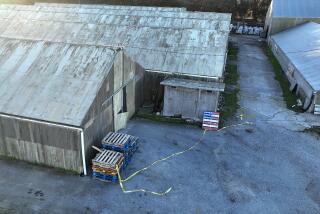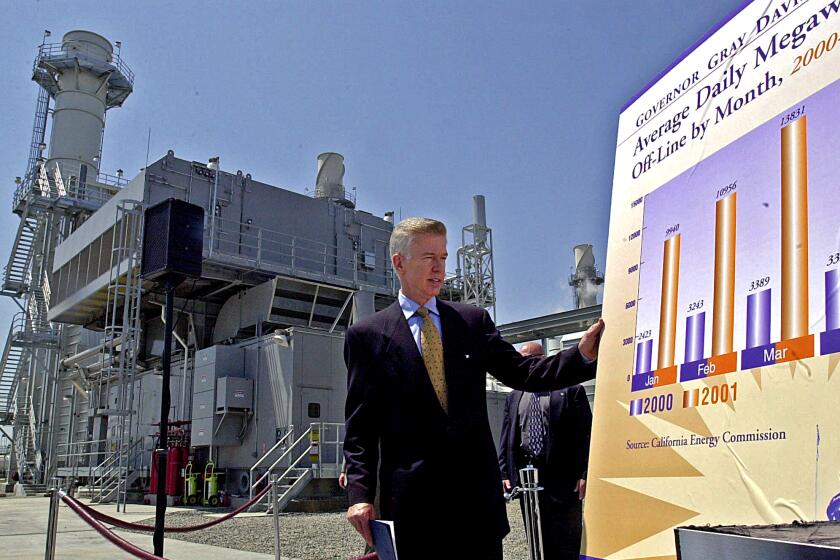1906 Quake Still Registers in S.F.
In today’s pre-dawn darkness, the signature San Francisco event commemorating the 1906 earthquake will unfold as it has for 30 years under the tutelage of one obsessive and free-spirited woman.
To mark the centennial, the city for the first time officially sponsored the reunion of quake survivors near an ornate Market Street fountain.
But behind that new veneer, scrambling as always to treat her beloved centenarians like royalty, is Taren Sapienza, who holds no city position, receives no compensation and no longer even lives in San Francisco.
Bighearted, sometimes spacey, always artistic and at times accident-prone, Sapienza has pretty much single-handedly shaped what has become this city’s only ritual to acknowledge those who perished in the quake and those who survived.
The days before the event find Sapienza hobbling on a broken foot -- a feather boa wrapped around her cane. The phone rings constantly. First, it’s the office of San Francisco Rep. Nancy Pelosi. Next, a relative of a 102-year-old survivor who is a last-minute addition.
Scattered on a basement floor of her parents’ Daly City home are the individual gifts she selected for each of more than a dozen survivors in a year-and-a-half shopping spree.
“Marie Sagues is very stylish and likes nice things,” Sapienza says. So the longtime attendee gets fine perfume. “Violet Lyman, my new survivor, I talked to her family and knew just what to get her,” Sapienza blurts, digging wildly through her parcels to show off crystal drinking glasses, blue ones (Lyman’s favorite color), and a decorative doll marked “Drama Queen.”
With the city’s imprimatur came logistical help with street closures and the promise of the largest attendance at Lotta’s Fountain since the commemoration’s modest start in 1924.
But die-hards who have long gathered in period costume to listen to the reminiscences of a bygone era favor the event’s more homespun flavor -- in keeping with a quirky San Francisco that is fading fast.
Firefighters in antique trucks used to mix bloody marys before dawn until department brass nixed the drinks a few years back. And the whole thing was pulled off without a permit.
“This is the heart of San Francisco,” said Hank Donat, a local blogger known as “Mister SF.” “This event wouldn’t be the same if it didn’t start with Taren tapping the microphone and saying, ‘Is this thing on?’ ”
At John’s Grill, the first San Francisco restaurant to rebuild after the 1906 quake, Sapienza worked a media-packed room Monday, welcoming her survivors like celebrities to a late afternoon meal as the crowd sang “San Francisco” and a bystander played a tiny banjo.
“Don’t you look gorgeous? I want your hat!” she hollered to Marcella Schiller, 101, a onetime opera singer in the 1920s who came in purple chiffon millinery.
Sapienza, 48, distinguished by an uncensored emotional intensity, a frosted mane and enormous blue eyes, has sleuthed out survivors in three states.
She has marshaled donated rooms for them at the posh St. Francis Hotel and used her own money to fill them with personalized gifts for her “little miracles.”
She has schemed tirelessly -- though unsuccessfully, she says with a pout -- as a matchmaker. And she has shed frequent tears as members of her beloved club pass away each year.
Survivors need to have been born in San Francisco in 1906 or earlier to participate, though Sapienza bent the rules for Norma Norwood, 99, who was conceived in post-quake passion, as the story goes, in a tent in Golden Gate Park. “I’m Catholic,” Sapienza shrugged. “You know, once it’s going, it’s a life.”
Memories of the quake and fires -- which destroyed most of the city and killed more than 3,000 -- have narrowed over time to impressionistic fragments: a mother’s arm pulling a child down the stairs, a cow wandering a city street, a brother returning from the rescue effort with a piece of rail track.
More than a history lesson, however, the event has become an opportunity to rouse the elderly from their sunset existence and treat them like royalty.
Wheelchair user Larry Cavagnero wept one year when he learned that Sapienza made special arrangements for him to get a steak at John’s Grill, since his nursing home never served it.
“This has been a labor of love,” Sapienza, a publicist, amateur jeweler and modeling talent agent, said last week.
“Plus, they’re a lot of fun,” she added, sharing her personal affinity with a mischievous grin. “At that age, they really don’t care what they say or do.”
Sapienza nearly fell off her chair laughing last year when Norwood told Mayor Gavin Newsom that the key to longevity was a daily drink and lots of sex, then offered him the key to her hotel room.
Today’s ceremony will almost certainly be the last to shower this much attention on survivors. As the event diminishes, a San Francisco tradition is coming to a close. It is one to which Sapienza -- who took over the event as a plucky teen from her now-88-year-old father -- is directly linked.
The commemoration began as a wreath-laying ceremony in 1924 by the South of Market Boys Club, a fraternity of working men from “south of the slot” -- or trolley tracks -- who initially gathered to honor their many fallen relatives at the fountain that had served as a message board in the post-quake chaos.
When Leo Sapienza joined the club, it included a mix of boxers, middle-class professionals, judges and politicians who assisted the elderly and the blind.
By age 7, Taren was her dad’s trusted assistant, helping with his booming real estate business, decorating for club breakfasts, hobnobbing with politicos.
And, year after year, she was there at Lotta’s Fountain, bonding with survivors like the five Dewey brothers, who came wearing matching bowler hats.
But the club was waning. “They were dying off -- the South of Market Boys,” Leo Sapienza, the last surviving club president, recalled, explaining how his daughter took over.
With the help of former beau Lee Houskeeper -- a publicist -- Sapienza expanded the event while sticking close to its anti-elite tradition.
“It had none of the chic which apparently invests this year’s,” said Quentin Kopp, a former South of Market Boy, longtime Bay Area lawmaker and judge. “It was a modest celebration -- for the survivors -- and there was a little bit of the eccentric to it.”
When the survivors got too old to travel from home to the event, Sapienza and Houskeeper prevailed on the Westin St. Francis to provide complimentary rooms.
When one corporate sponsor abruptly pulled out nine years ago, See’s Candies’ now-retired president and chief executive, Chuck Huggins, stepped in. His wife, Donna Ewald Huggins, had been donning a red Barbary Coast dress and playing the role of San Francisco’s Lillie Coit -- the 19th century patroness of the city’s firemen -- since she was a teenager.
“Taren can make you crazy, but she does it to get to the goal,” Ewald Huggins said. “She’s the kind of person who on the afternoon after the earthquake in 1906 would have either had a boarding house running, figured out how to rebuild her house, or talked everyone else in town into doing it.”
Sapienza moved to Carlsbad five years ago, and now organizes the event from afar.
The ritual includes a guaranteed dose of grief: In the past month and a half alone, three participants passed away.
“I call her and she’s just inconsolable,” Houskeeper said.
But happy moments have come from new connections. Her discovery of the Meyers sisters -- Elvira, Elisa, Celia and Flora -- rescued her from devastation just months after the last of the Dewey brothers passed away. Now only Elisa remains.
“She made them feel like queens,” said Celia’s 69-year-old son, Joe Ramirez.
For years, Sapienza worked to find a Chinese participant, mindful that the discrimination suffered after the quake by San Francisco’s Chinese community made those survivors less eager to ponder the past.
With help from Willie Brown -- the first mayor to attend the event -- Sapienza found Bessie Shum, and later Janie Chu, now both deceased. On the stage at Lotta’s Fountain in 2000, Brown presented a certificate of apology to the city’s Chinese community. “I felt like Lincoln freeing the slaves,” Sapienza recalled, tearing up. “I can’t tell you how heartfelt it was. They were so grateful.”
Sapienza still hopes to find an African American or Latino survivor. But time is running out.
Sapienza has talked of returning the ritual to its simple wreath-laying roots. But she called her detailed plans a “surprise” that she promised to announce this morning.
For survivors like Sagues, who has attended about a dozen ceremonies, the prospect of an end is a melancholy one.
“It makes me very sad,” said Sagues, 100, who lives on her own in Kentfield, north of San Francisco. “I’ve enjoyed every one of them.”
More to Read
Start your day right
Sign up for Essential California for news, features and recommendations from the L.A. Times and beyond in your inbox six days a week.
You may occasionally receive promotional content from the Los Angeles Times.






